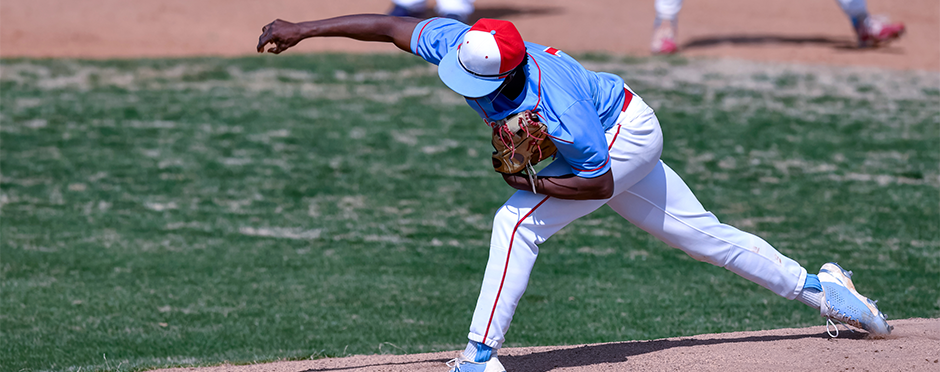
3 Traits of a Successful Pitcher
Leave a CommentHenry Chadwick is credited with creating the first baseball statistics in the late 1800’s.1 To gauge a batter’s success, he formulated the batting average (hits divided by at-bats), and for pitchers, the ERA (earned runs given up per 9 innings pitched). Today, with groups like Fangraphs.com and the Society for American Baseball Research, there are mind boggling ways to analyze and predict the performance of baseball players.
No matter how you dice up the numbers, the pitcher’s ultimate responsibility is to make it difficult for the other team to score runs. This is why the ERA has become the standard measurement for a pitcher’s success, or failure. Keep your ERA low and you’re a success! But we all know it’s not that easy. Just ask the countless number of ex-players who never made it to the big leagues. So what do the guys who make it have that the other guys don’t?
Athleticism
P.J. Finigan, pitching coach at Southern Illinois University at Carbondale, puts athleticism at the top of his list when it comes to traits of successful pitchers.2 On Insidepitching.com he states that “having the athletic ability to consistently repeat their delivery” and having “the athleticism to be able to make mechanical changes when needed” are both characteristics that pitchers should have.2
The need for this type of pitcher exists at all levels, and is important to all coaches. In scientific terms, athleticism is the equivalent of efficient kinematics and biomechanics. Slow motion video analysis has given researchers the capacity to break down the most effective and efficient pitching mechanics. This includes the pitcher’s posture at various points of delivery, appropriate stride lengths, hip rotation, balance points, as well as angles in the legs, hips, shoulders and arms.
Dr. Glen Fleisig, author of numerous studies on baseball throwing, suggests that one key to future success is training proper mechanics at a young age. As younger pitchers hit growth spurts and develop larger musculoskeletal bodies, their velocity also increases. Those who are already throwing with good mechanics are less likely to get injured, while making it easier to fine tune their delivery and focus on improving their performance.3
Work Ethic
Work ethic starts with passion. As quoted by Wayne Gretzky, “Maybe it wasn’t talent the Lord gave me, maybe it was the passion.” In his book, “the Sports Gene,” David Epstein devotes a whole chapter on the genetics of work ethic, drive and intrinsic motivation. Based on animal research, he postulates that while human drive to “work hard” is part nurture, there is a strong correlation to our genetic make-up.4 Although any pitcher can improve his or her performance by working with pitching and strength coaches, those who do extra work on their own will most likely outperform their competition.
Successful pitchers spend time alone fine tuning their mechanics, running for cardiovascular endurance, strength training to improve performance and reduce risk of injury, and studying other successful pitchers. There are many quotes that characterize this type of athlete, such as “going the extra mile,” “giving it 110 percent,” “a gym rat,” “a student of the game,” etc.
Intelligence
Yogi Berra told us that “Baseball is 90 percent mental, and the other half physical.” I didn’t like math either Yogi, so this makes perfect sense to me. As mentioned above, to be a successful pitcher you must keep your ERA low. This means getting more batters out than you let score.
The key to getting outs is keeping the batter off balance. It would be nice to strike everyone out, but even flame throwers who regularly hit 95 MPH or greater can’t strike everyone out. There are a few ways to keep batters off balance. One is to throw very hard. This decreases the time a hitter has to see the ball, and increases the chances they will not make good contact. But what if you don’t throw hard? Other ways to keep a batter off balance include ball movement and changes in location. Having the capacity to throw a ball to the location you would like (athleticism), along with keeping the batter guessing where the ball will go next, places the advantage in the pitcher’s hands (literally). A successful pitcher will use past experiences and formulate a strategy to always keep the batter uncertain and off balance.
Stay Healthy
In addition to the traits listed above, pitchers must pay attention to their bodies and stay healthy in order to be successful at their position. Although some discomfort in the throwing arm is normal after a pitching session, this discomfort should be monitored and addressed if it doesn’t subside or becomes worse. When this occurs, it is a good idea to contact your nearest Athletico location to schedule a complimentary injury screening.
The Athletico blog is an educational resource written by Athletico employees. Athletico bloggers are licensed professionals who abide by the code of ethics outlined by their respective professional associations. The content published in blog posts represents the opinion of the individual author based on their expertise and experience. The content provided in this blog is for informational purposes only, does not constitute medical advice and should not be relied on for making personal health decisions.
1. “Henry Chadwick.”National Baseball Hall of Fame. N.p., n.d. Web. 6 June 2017.
2. “Three Characteristics of a Good Pitcher.”Inside Pitching. N.p., 31 Mar. 2011. Web.
3. Fleisig, Glenn S., et al. “Kinematic and kinetic comparison of baseball pitching among various levels of development.” Journal of biomechanics12 (1999): 1371-1375.
4. Epstein, David. “the Sports Gene.” New York, New York: Penguin Group, 2014, Print.
